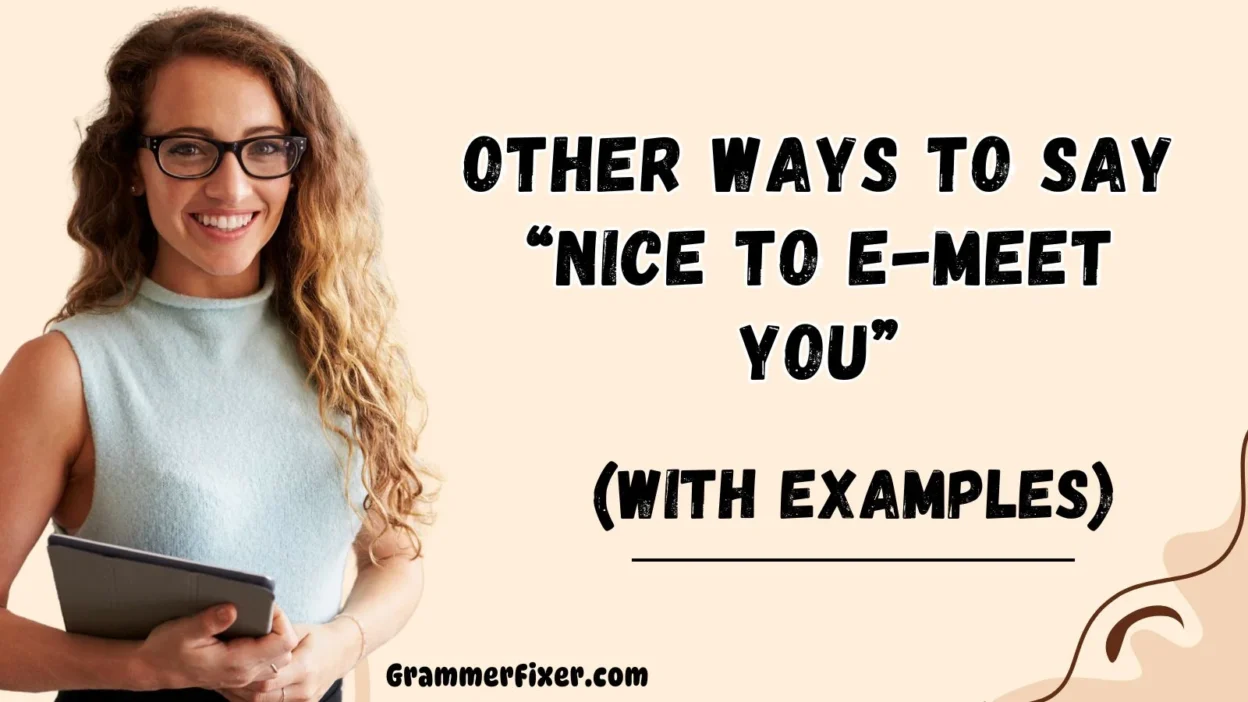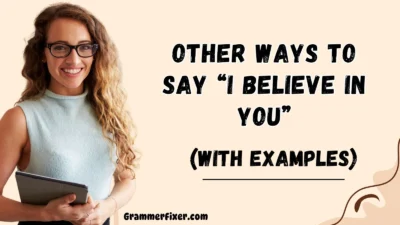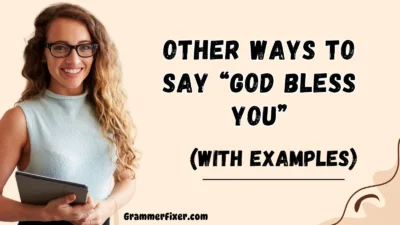In today’s digital world, the phrase “Nice to E-Meet You” has become a go-to virtual greeting, especially when introducing ourselves in emails, messages, or video calls. But while it’s common, it can sometimes feel overused, impersonal, or cliché—particularly when first impressions matter.
Whether you’re a professional, a job candidate, or a business owner, having a range of warm, thoughtful, and creative alternatives allows you to express yourself with genuine care and professionalism.
Below, we’ll explore 30 polished and empathetic ways to greet someone virtually while staying polite, respectful, and impactful.
What Does “Nice to E-Meet You” Mean?
The phrase “Nice to E-Meet You” is a modern twist on “Nice to meet you”, adapted for digital interactions. It acknowledges that you’re connecting online rather than face-to-face. Often used in emails, virtual introductions, or LinkedIn messages, it carries the sentiment of politeness and gratitude in a professional setting.
Is It Professional/Polite to Say “Nice to E-Meet You”?
Yes, it is generally considered professional and polite, especially when introducing yourself via email or other virtual platforms. However, it can sometimes feel too generic or outdated, particularly in modern, creative, or tech-savvy environments. Choosing a more personalized or tone-fitting greeting can make your communication more memorable and authentic.
Advantages and Disadvantages of Using “Nice to E-Meet You”
Advantages:
- Easy to use and widely recognized
- Conveys basic politeness and professionalism
- Works across industries and with clients, recruiters, or colleagues
Disadvantages:
- May sound robotic, impersonal, or overused
- Lacks originality or emotional warmth
- Can feel awkward in more casual or creative settings
1. Great to Connect With You
Meaning: A friendly, slightly more modern take that highlights the act of connection.
Detailed Explanation: This phrase emphasizes the relationship-building aspect of the meeting, rather than the medium of it.
Scenario Example:
“Hi Sarah, great to connect with you—I’ve heard wonderful things about your work in digital media.”
Best Use: Perfect for LinkedIn messages, email introductions, or professional follow-ups.
Tone: Warm, neutral-professional, and natural.
2. A Pleasure Making Your Acquaintance
Meaning: A formal and classic phrase used to show respect and courtesy.
Detailed Explanation: This is a great choice when you want to appear polite, especially in corporate, international, or high-stakes settings.
Scenario Example:
“Dear Mr. Lawson, a pleasure making your acquaintance—I’m excited to collaborate on this quarter’s deliverables.”
Best Use: Excellent for formal business emails or introductions with senior professionals.
Tone: Professional, respectful, and slightly traditional.
3. Happy to Be in Touch
Meaning: Conveys genuine positivity about beginning a new communication channel.
Detailed Explanation: This is a friendly yet versatile phrase that fits many digital platforms.
Scenario Example:
“Hi Ella, happy to be in touch! I’m looking forward to learning more about your team’s goals.”
Best Use: Great for email greetings, LinkedIn networking, or freelance outreach.
Tone: Pleasant, light, and professional-casual.
4. Delighted to Connect Digitally
Meaning: Puts emphasis on the digital nature of the interaction with enthusiasm.
Detailed Explanation: This is a modern alternative that works well in tech, startup, or creative industries.
Scenario Example:
“Hi Kevin, delighted to connect digitally—thank you for reaching out about the innovation workshop.”
Best Use: Useful in remote collaborations, web-based introductions, or conference follow-ups.
Tone: Cheerful, tech-friendly, and forward-thinking.
5. Wonderful to Cross Paths (Even Virtually)
Meaning: A slightly poetic, empathetic greeting that reflects the serendipity of meeting.
Detailed Explanation: This shows appreciation for the opportunity to meet, despite the digital medium.
Scenario Example:
“Hi Dana, wonderful to cross paths—even virtually! I’ve long admired your work on organizational culture.”
Best Use: Ideal for networking, mentorship connections, or socially-driven roles.
Tone: Warm, gracious, and a bit philosophical.
6. It’s a Pleasure to Connect
Meaning: A polished and versatile expression of gratitude for the new connection.
Detailed Explanation: Slightly more refined than “Nice to E-Meet You,” this phrase communicates respect, gratitude, and a positive attitude.
Scenario Example:
“Hi Maria, it’s a pleasure to connect. I’ve reviewed your recent article on hybrid workspaces—excellent insights!”
Best Use: Effective in both formal and informal email introductions, especially in professional networking.
Tone: Polite, gracious, and welcoming.
7. Honored to Make Your Acquaintance
Meaning: A very formal and respectful greeting, appropriate when prestige or seniority is involved.
Detailed Explanation: Expresses deep professional respect and an elevated tone, often used when introducing yourself to someone with an impressive reputation or accomplishments.
Scenario Example:
“Dear Professor Smith, I’m honored to make your acquaintance. Your research on innovation culture has influenced my work.”
Best Use: Ideal for academic, government, or executive-level introductions.
Tone: Highly respectful, formal, and elevated.
8. Excited to Start This Conversation
Meaning: Signals eagerness and enthusiasm for a fruitful interaction.
Detailed Explanation: Goes beyond pleasantries to emphasize your willingness to engage, brainstorm, or collaborate.
Scenario Example:
“Hi Jasmine, excited to start this conversation! I think we’ll find strong alignment between our teams.”
Best Use: Great for kick-off meetings, project partnerships, or collaboration emails.
Tone: Optimistic, enthusiastic, and forward-looking.
9. Glad We’re Finally Connecting
Meaning: Acknowledge the anticipation or delay before meeting, in a friendly and relatable way.
Detailed Explanation: Suggests that the meeting is long-awaited or mutually desired, making it more personal.
Scenario Example:
“Hi Rehan, glad we’re finally connecting—I’ve been meaning to reach out since your keynote in October.”
Best Use: Perfect for follow-up emails, LinkedIn connections, or delayed responses.
Tone: Friendly, conversational, and slightly informal.
10. It’s Great to Be in Communication With You
Meaning: Emphasizes the communication aspect while remaining polite and slightly formal.
Detailed Explanation: This phrasing works especially well when you’re looking to keep the tone neutral and clear, without being too casual.
Scenario Example:
“Dear Dr. Allen, it’s great to be in communication with you regarding the quarterly reporting system.”
Best Use: Best for professional service emails, consulting, or client-based roles.
Tone: Respectful, neutral, and business-appropriate.
11. I’ve Heard Great Things—Nice to Finally Meet
Meaning: Compliments the recipient while acknowledging the anticipation or familiarity.
Detailed Explanation: Combines positive sentiment, a touch of flattery, and familiarity for a strong opening impression.
Scenario Example:
“Hi Tim, I’ve heard great things—nice to finally meet. I’m looking forward to collaborating on the onboarding process.”
Best Use: Effective in colleague introductions, internal team building, or referrals.
Tone: Friendly, personal, and genuine.
12. Looking Forward to Collaborating
Meaning: Expresses forward-thinking intent and a desire to work together constructively.
Detailed Explanation: More action-focused, this greeting is best used when a project, partnership, or conversation is about to begin.
Scenario Example:
“Hi Alex, looking forward to collaborating! Your experience with product launches will be invaluable.”
Best Use: Great for team introductions, cross-functional projects, or freelancer-client communications.
Tone: Motivated, positive, and partnership-focused.
13. Grateful for the Opportunity to Connect
Meaning: Shows humility and thankfulness for the introduction or connection.
Detailed Explanation: This option is particularly thoughtful in situations where the person is a potential mentor, client, or someone whose time is valuable.
Scenario Example:
“Hello Ms. Ray, grateful for the opportunity to connect. Thank you for taking the time to speak today.”
Best Use: Ideal in recruiting, sales introductions, or mentor relationships.
Tone: Humble, respectful, and professional.
14. A Joy to Make Your Digital Acquaintance
Meaning: A playful yet polite phrase that acknowledges the online nature of the introduction.
Detailed Explanation: Adds creative flair while remaining polite, making it a memorable and delightful greeting.
Scenario Example:
“Hi Kenji, a joy to make your digital acquaintance! I’ve been following your work in UX strategy.”
Best Use: Suitable for tech industries, startups, or social media introductions.
Tone: Creative, tech-savvy, and light-hearted.
15. Delighted We Could Finally Connect Online
Meaning: Combines anticipation and appreciation, perfect for delayed or long-awaited meetings.
Detailed Explanation: This phrasing fits moments where schedules didn’t align previously, or introductions were postponed.
Scenario Example:
“Hi Carol, delighted we could finally connect online. I’ve been eager to explore how our projects overlap.”
Best Use: Best for collaboration calls, consulting, or networking events.
Tone: Warm, welcoming, and gracious.
16. Thrilled to Be Connected
Meaning: A vibrant and enthusiastic way to express joy about the new connection.
Detailed Explanation: This phrase adds a spark of energy to your greeting, making it perfect for energizing introductions or exciting opportunities.
Scenario Example:
“Hi Nina, thrilled to be connected! I’ve been following your work with early-stage startups—very inspiring.”
Best Use: Ideal for networking, creative collaborations, or startup ecosystems.
Tone: Enthusiastic, upbeat, and passionate.
17. I Appreciate the Introduction
Meaning: Shows gratitude for being connected, especially through a mutual contact.
Detailed Explanation: This is best used when someone has made the connection for you (e.g., a recruiter, mutual colleague).
Scenario Example:
“Hi Amir, I appreciate the introduction—thanks to Karen for linking us. Excited to learn more about your projects.”
Best Use: Perfect for mutual connections, referrals, and recruiter outreach.
Tone: Grateful, respectful, and acknowledging.
18. It’s Lovely to Meet You (Even Virtually)
Meaning: Brings in warmth and politeness, with a nod to the digital format.
Detailed Explanation: Especially useful in casual-professional interactions, this makes your greeting feel genuine and kind.
Scenario Example:
“Hi Sophie, it’s lovely to meet you (even virtually). I’ve heard so much about your contributions to the design team.”
Best Use: Great for creative industries, internal teams, or online meet-and-greets.
Tone: Friendly, gentle, and sincere.
19. Great to Finally Put a Face to the Name
Meaning: Expresses satisfaction at finally seeing someone you’ve only known digitally.
Detailed Explanation: This is a great fit after video calls or web conferences where visual interaction occurs.
Scenario Example:
“Hi Daniel, great to finally put a face to the name. I enjoyed your presentation during the virtual town hall.”
Best Use: Perfect for video introductions, conference follow-ups, or remote team intros.
Tone: Warm, conversational, and relatable.
20. Thanks for Reaching Out—Great to Connect
Meaning: Acknowledges the person’s initiative and pairs it with a professional greeting.
Detailed Explanation: A polite way to respond when someone introduces themselves or responds to your message.
Scenario Example:
“Hi Priya, thanks for reaching out—great to connect! I’d love to hear more about your ideas.”
Best Use: Great for responses, inbound inquiries, or new client conversations.
Tone: Appreciative, courteous, and open.
21. A Warm Hello and Welcome
Meaning: More than just a greeting, it’s a cordial and inviting introduction.
Detailed Explanation: Works well when you’re introducing yourself as a host, team lead, or mentor.
Scenario Example:
“A warm hello and welcome, Sandra. We’re happy to have you on board for the upcoming quarterly planning.”
Best Use: Ideal for onboarding, team welcomes, or networking group moderators.
Tone: Warm, friendly, and inclusive.
22. I’m Glad We Connected Through LinkedIn
Meaning: A context-specific phrase that references the platform of the connection.
Detailed Explanation: Useful for quickly establishing the channel of contact, and adds a personalized feel.
Scenario Example:
“Hi Jordan, I’m glad we connected through LinkedIn. Your background in tech innovation is impressive.”
Best Use: Best for social media networking, especially on LinkedIn or professional forums.
Tone: Professional, acknowledging, and platform-aware.
23. Thanks for the Opportunity to Introduce Myself
Meaning: Highlights the formality and humility of being able to connect.
Detailed Explanation: This is a great greeting for job seekers, freelancers, or anyone trying to make a professional impression.
Scenario Example:
“Hi Dr. Kapoor, thanks for the opportunity to introduce myself. I’d be honored to contribute to your team.”
Best Use: Ideal for cold outreach, candidate introductions, or consulting proposals.
Tone: Respectful, professional, and self-aware.
24. Pleased to Make This Digital Introduction
Meaning: A slightly modernized twist on “pleased to meet you.”
Detailed Explanation: A good middle ground between formality and virtual awareness, suitable for multiple industries.
Scenario Example:
“Hello Mr. Thompson, pleased to make this digital introduction. I’ve admired your leadership in policy reform.”
Best Use: Perfect for corporate, legal, or government contexts.
Tone: Professional, modern, and polished.
25. Thanks for Taking the Time to Connect
Meaning: Acknowledges the person’s time and effort in making the introduction possible.
Detailed Explanation: This greeting sets a respectful tone from the outset and works well for busy professionals.
Scenario Example:
“Hi Zoya, thanks for taking the time to connect. I value the chance to exchange ideas on future collaboration.”
Best Use: Great for busy executives, clients, or potential mentors.
Tone: Gracious, respectful, and time-conscious.
26. It’s Been a Long Time Coming—Happy We’re Connected
Meaning: Signals a delayed or much-anticipated connection.
Detailed Explanation: Conveys a sense of relief and excitement to finally meet, either online or through mutual circles.
Scenario Example:
“Hey Mark, it’s been a long time coming—happy we’re connected! Let’s catch up on our shared projects.”
Best Use: Ideal for follow-ups, old acquaintances, or delayed networking.
Tone: Casual, optimistic, and reconnecting.
27. I’ve Been Looking Forward to This Introduction
Meaning: Builds anticipation and positive expectation.
Detailed Explanation: Sets a purposeful tone and communicates that the meeting is important and welcomed.
Scenario Example:
“Hi Fiona, I’ve been looking forward to this introduction. I’m confident there’s room for collaboration.”
Best Use: Best for strategic partnerships, interviews, or pre-arranged introductions.
Tone: Intentional, enthusiastic, and focused.
28. A Virtual Hello and Thank You for Connecting
Meaning: A polite and contextualized greeting that highlights the virtual setting.
Detailed Explanation: Combines a greeting with a note of gratitude for the connection, perfect for initial interactions.
Scenario Example:
“Hi team, a virtual hello and thank you for connecting. Looking forward to being part of this brainstorming session.”
Best Use: Effective in group messages, team intros, or webinar follow-ups.
Tone: Polite, neutral, and inclusive.
29. It’s Always Nice to Meet a Fellow Professional
Meaning: Creates instant bonding and familiarity, especially within similar industries.
Detailed Explanation: Highlights shared experience and a sense of community, helpful when building rapport.
Scenario Example:
“Hi Omar, it’s always nice to meet a fellow professional in product development. I hope we can exchange insights.”
Best Use: Great for networking, peer introductions, or professional forums.
Tone: Respectful, collegial, and affirming.
30. Thank You for Connecting—Looking Forward to the Conversation
Meaning: Expresses appreciation and sets the tone for ongoing dialogue.
Detailed Explanation: Perfect for ongoing relationships, this phrase sets expectations for a mutually valuable exchange.
Scenario Example:
“Hi Lila, thank you for connecting—looking forward to the conversation around your nonprofit initiatives.”
Best Use: Excellent for discovery calls, intro meetings, or partnerships.
Tone: Open, professional, and collaborative.
Conclusion
Choosing how to say “Nice to E-Meet You” might seem like a small thing, but the words you choose can make a lasting impression. Whether you’re trying to sound warm, respectful, professional, or just a little more creative, having the right alternative greeting helps you tailor your tone, build rapport, and set the stage for effective digital communication.
With these 30 thoughtful alternatives, you can better express gratitude, enthusiasm, and professionalism in any virtual setting—from email introductions to LinkedIn messages, team calls, or client onboarding.



